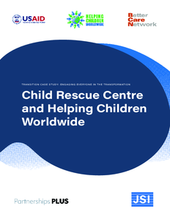The Child Rescue Centre (CRC) in Sierra Leone began as a faith-based residential children’s home established in 2000 with 40 children rescued from the streets during the last two years of a brutal 10-year civil war.
It was founded through a partnership between a United Methodist Church (UMC) congregation in the US and the UMC Sierra Leone Annual Conference. Within a year, the center added a family preservation program designed to provide material and financial support to at-risk families and remove the need for families to send their children to the orphanage. Over the years, the partnership grew to include more than 10 US churches, and the establishment of a US registered charity called Helping Children Worldwide. The two programs ran side by side until 2016, when the orphanage Director, himself a Care Leaver of the orphanage, approached Helping Children Worldwide (HCW), and HCW’s director of programs began a serious dialogue about the impacts they were seeing on the children. They then approached the leadership of HCW and the Bishop of Sierra Leone about the possibility of transitioning all its programming to family-oriented models of care. This initiated a process of transition, that over a two-year period, resulted in the reintegration of all 40 children in the residential program and the standing up of a case management system to support children and their families and ensure permanence.
The Child Rescue Centre was the first orphanage in Sierra Leone to successfully complete a transition from residential to family-based care. This case study highlights some of the key dynamics that arose throughout the transition of the orphanage and examines how those dynamics both influenced the transition and determined the type of support provided as well as the most appropriate transition strategy. The case study is organized around the various stages of transition and explores some of the key themes outlined in the Transitioning Models of Care Assessment Tool. Finally, the case study demonstrates how the organizations’ approach of radical honesty and radical collaboration at every level throughout the process was a critical component in its success.
*Names and locations of organizations and individuals have been changed; however, the details represent a true account.

